How To Respond To A 1 Star Review Without Comments
Why are reviews important?
Consider your future customer In today's marketplace, customers rely upon reviews to vet local businesses. In fact, 85% of customers trust online reviews as much as a personal recommendation. Let's say that you're a consumer searching for a local car dealership. You head to Google, type in a few keywords, and are faced with the following two options.
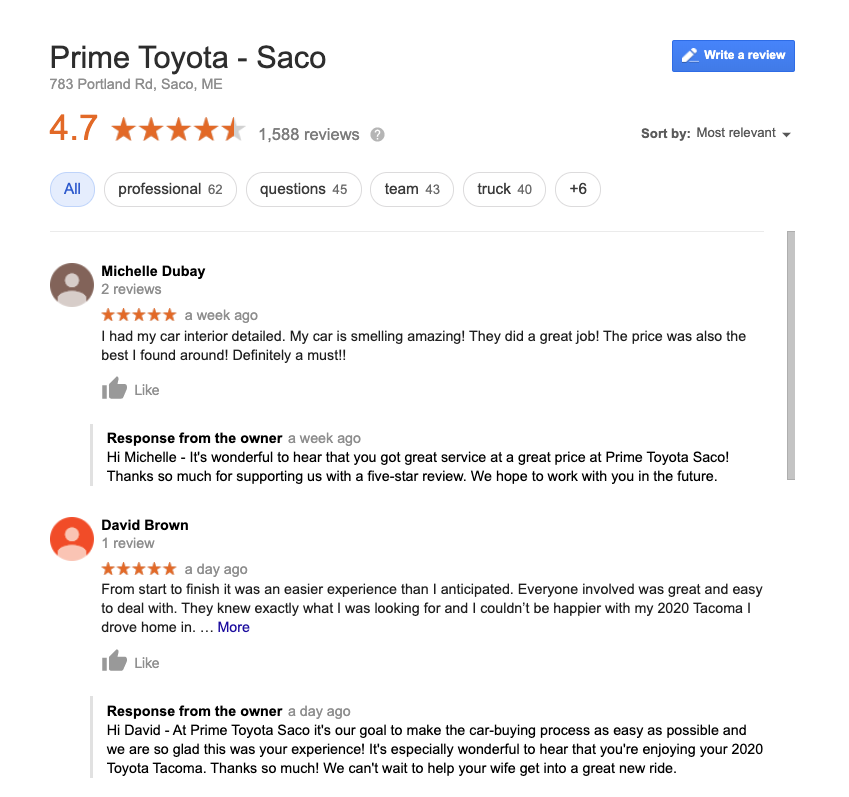
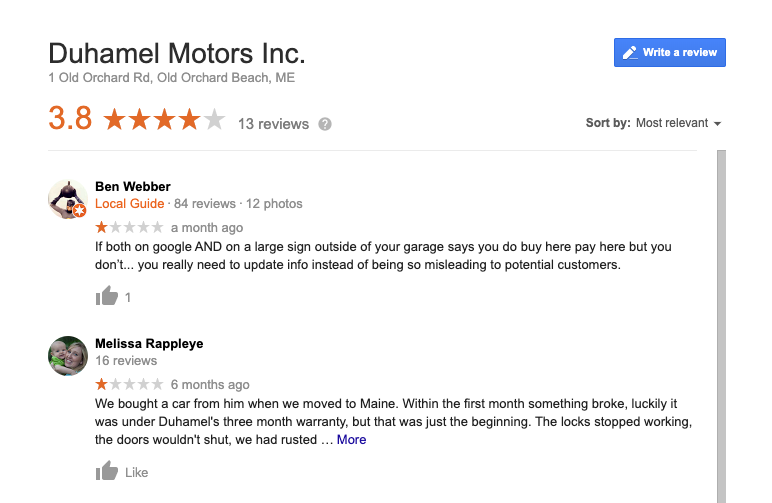
Clearly, you're going to choose #1. And you're not alone. Consumers read an average of 10 reviews before they feel they can trust a local business (Brightlocal). 57% of consumers will only consider a business if it is rated 4 stars or higher. This last statistic is especially important to keep in mind. Did you know that there are certain search situations in which Google only displays businesses with ratings above 4.0? See the example below:
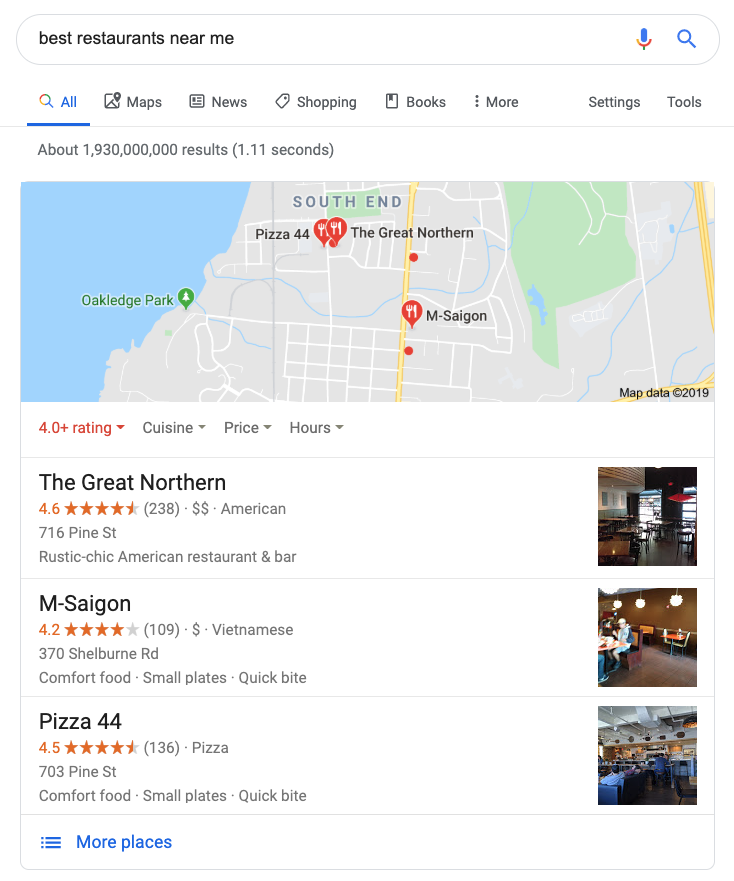
While this might be frustrating for businesses rated 3.9 or lower, it makes sense. Google's best interest is to show searchers the results that are most likely to offer a proven good experience. That means businesses with higher ratings get a boost. If your business doesn't have many reviews, potential customers will have less information to help them make a decision about where to shop. Even worse, they are less likely to find your business in the first place.
"The prominence of reviews isn't particularly shocking, as it's a way for Google to crowdsource ranking factors, it's hard to spam, and the most problematic type of abuse is illegal."
Source: Local SEO Guide

Reviews dominate local SEO In traditional SEO, reviews have a relatively modest impact on ranking. But local search is a different story. Reviews play an outsized role in local search rankings (specifically the Local Pack). According to Moz, reviews are the second most important ranking factor in 2020, moving up from third, surpassing proximity. This change means the expected quality of experience (reviews) is more important than where the searcher is physically (within reason). Because of this, review management should be a core part of your business's SEO strategy. A great way to explain this is what we call the "deli example" (illustrated below). Say you are in a new city, it's lunchtime, and you would like to find a good deli nearby. You search "deli near me". Historically, Google would recommend the closest deli first. In the case of this example, Deli A. Today, if Deli B has more reviews and higher ratings, Google will recommend Deli B first, in spite of the fact that the searcher will have to walk a few more blocks. A significant change, the local business can now proactively influence search visibility for a wider geographic area, While the business has no control over where a search comes from, managing reputation information to influence search ranking is well within the business's control. If you think about it from Google's perspective, it makes total sense. Its business relies upon searchers being satisfied with the businesses Google recommends. How does it pick the best businesses to recommend? Reviews. Always be listening Reviews are an excellent source of feedback. Satisfied customers will rave about the products they love, while unhappy guests will explain what went wrong during their visit. That's right, even negative reviews can be beneficial. Customer feedback is a great way to improve your business offerings and monitor customer experience trends over time.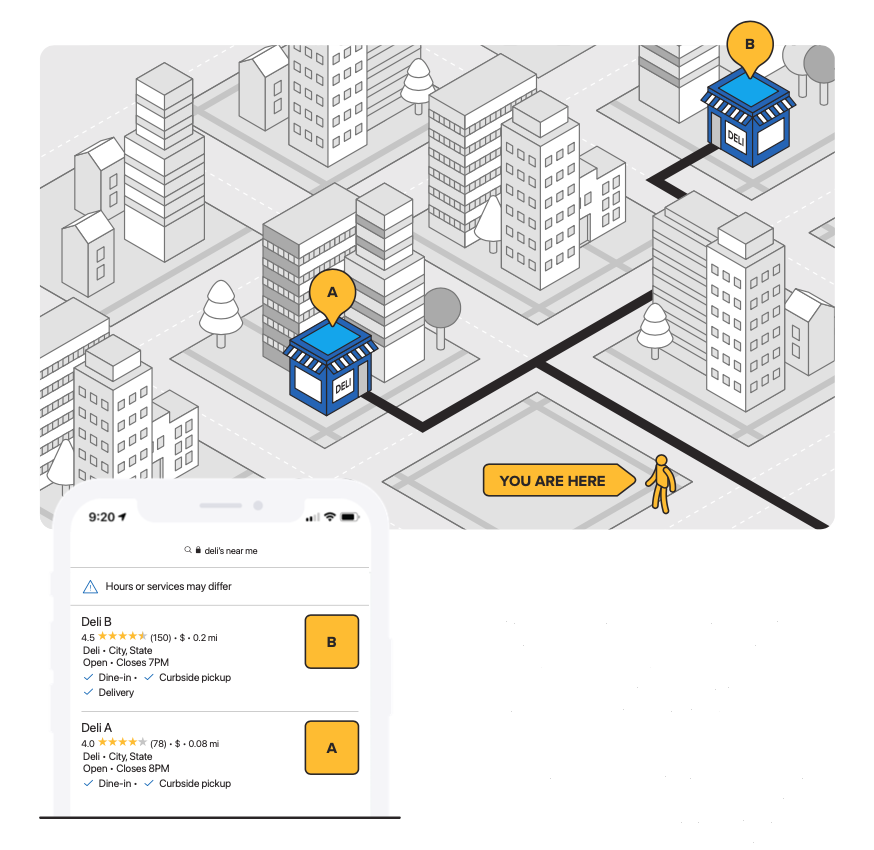
Yes. As a business owner with admin access to your Google My Business page you are able to monitor and respond to customer reviews. Here's how you Reply to Google Reviews Sign in to Google My Business by navigating to business.google.com Select "Reviews" on left-side navigation To respond to a review select "View and reply" If you would like to get a direct link to your review page that you can share, go to business.google.com, and from your home page find "Get more reviews" and select "Share review form" to access the link.Can you respond to Google reviews?
Why respond to reviews?
Now that we understand why reviews matter, let's discuss why responses matter just as much. Review response is all about taking control of your business's public-facing content. While the internet can sometimes feel like a one-way conversation, responding to reviews gives your business a voice. Significant SEO Impact Here are the review factors that influence SEO: Volume Rating Keywords Unique, up-to-date, and ongoing content If you are interested in digging into this topic in more detail, check out our guide: How Reviews Impact Local SEO. Volume More reviews will enable your customers to get a better understanding of the experience they can expect to have at your store. Responding can boost this effect, the Harvard Business Review finding in a recent study that businesses who respond consistently get 12% more reviews. Worried about a negative review? A pile of new 5-star reviews will help drown out an isolated negative experience. Potential customers are looking for trends, not individual situations. Review volume also keeps your information current. According to BrightLocal, 40% of customers only take into account reviews written in the prior two weeks. Considering that this statistic increased 18% from the year prior, we think this trend will continue. An even more reliable way to get more reviews is through our review generation product Invite. You can use Invite to request reviews from individual customers via text, or you can sync it up with your point of sale system to reach all of your customers automatically. "Businesses who respond consistently get 12% more reviews" Rating Your online business rating is likely the first quality indicator your potential customers will see. At a minimum, a rating above 4.0 should be your target. This will get you past the first round of cuts. Generally, 4.0-4.5 is good and 4.5-5.0 is the top of the pack.
Source: Harvard Business Review
Keywords This is where Google review management really comes into play. Yes, your customers' reviews will sometimes contain keywords, but responding gives you the chance to ensure Google knows exactly what your business is about. Relevant keywords to consider in your review responses: Business name Location Products Services Compare these two responses. Which one has a better SEO value?
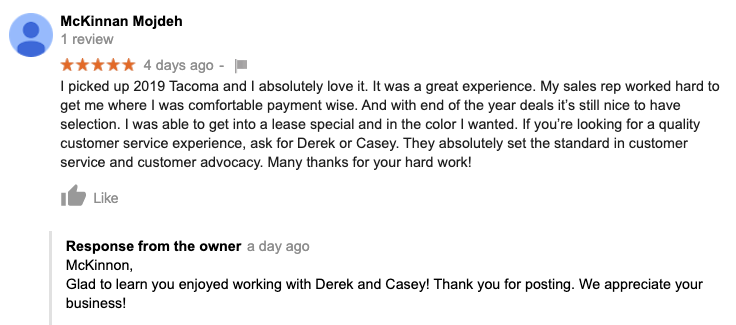
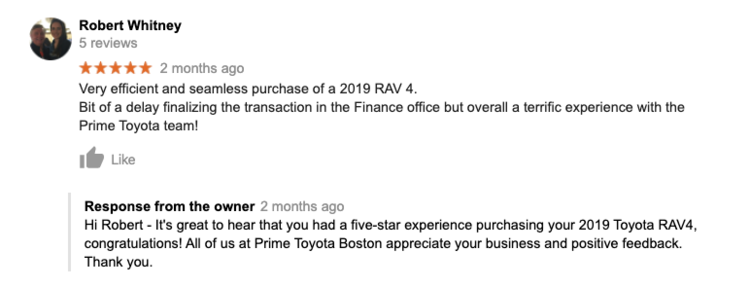
Both are pleasant, but number two also provides Google with helpful information. The second response lists the accurate name of the business and the full product name. The customer mentioned "Prime Toyota", but complete business name is "Prime Toyota Boston". By responding, Google now has access to the proper name. Unique, up-to-date, and ongoing content To Google, a strong indicator of a healthy and active business is new content on a consistent basis. Responding to reviews will effectively double your GMB content activity.
"Among consumers that read reviews, 97% read businesses' responses to reviews."
Source: Brightlocal
The "Adult in the Room" Theory By actively participating in your business's review conversation, you are likely to see a drop in short, negative reviews. If a customer know that the manager is likely to read and respond to their review, they will be less likely to leave a trivial negative review. The remaining negative reviews will provide feedback for your team or an opportunity to remedy a poor situation. Identify and Solve Problems Early Conventional wisdom says addressing a problem is better than letting it fester. Reviews are no different. In our experience, dealing with a customer frustration head-on as quickly as possible is most likely to lead to a positive outcome. Furthermore, responding to reviews demonstrates to future customers that if they patronize your business and have a problem they can expect prompt customer service. Better customer service = happier customers!
8 Types of Review Responses
Types of Review Responses: No response Negative-negative response Barely-there response Spellcheck response Robo response Eager-beaver response Keyword-less response Widewail response
1. No Response Coming in dead last: no response at all. Reviews stack up without acknowledgment. Hundreds of customers go unthanked. Rude language and misinformation remain online. All in all, ignoring reviews makes it look like the company doesn't care about its guests or its reputation. 2. The Negative-Negative Response The positive reviews get the attention they deserve, but negatives go overlooked. This might be the worst message to send potential customers: that guests without complaints will be treated with kindness but those looking for help will be ignored. Even beyond customer service, negative reviews provide valuable information to businesses about how they can improve. The only thing worse than ignoring negatives is responding to them in anger. No matter what the review says, answering in an aggressive tone makes the company seem petty and will invite a very public customer service fire. 3. The Barely-There Response One step above ignoring reviews is responding with as little effort as possible. Each positive review receives the same "Thank you," while unhappy customers are provided a general email address where they can send their feedback. At least there is an answer, but no one believes that anyone from the company is actually concerned about resolving their patrons' problems.
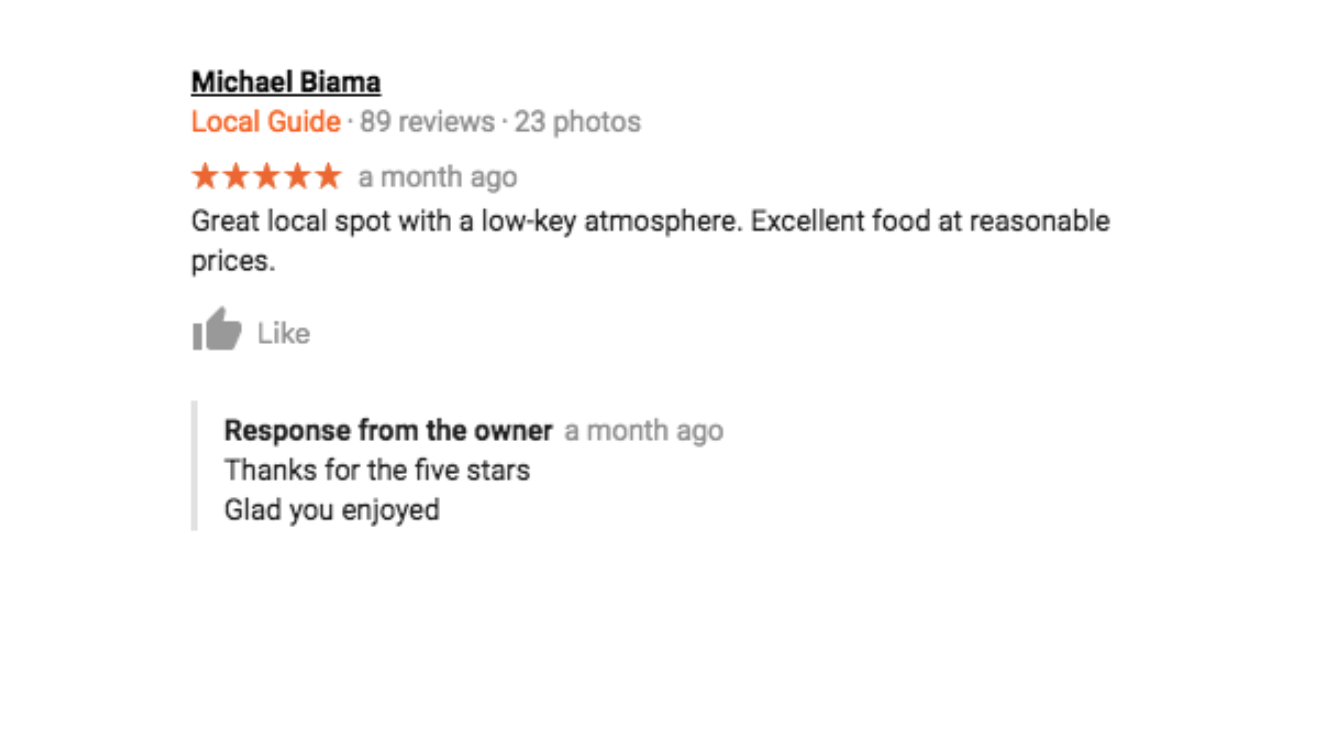
4. The Spellcheck Response Even a response that contains great content can be ruined with grammar issues, incorrect spelling, and awkward prose. Mistakes like these, especially ones that would be fixed with a simple proofread, paint the company in a very unprofessional light. If the business doesn't care about the details when it comes to communicating with their clients, will their care about the details when it comes to their service? 5. The Robo Response It's obvious that these responses are copied and pasted from a template, or otherwise written by a machine. While detached responses might seem like the most professional option, they may further upset unhappy customers. These dissatisfied guests are looking for answers and they want to speak to a real human, not an automated message. Future customers might be turned off as well, believing that the service they can expect in person will be as cold as the interactions they viewed online. Read the pros and cons of an automated vs. managed service review response solution.
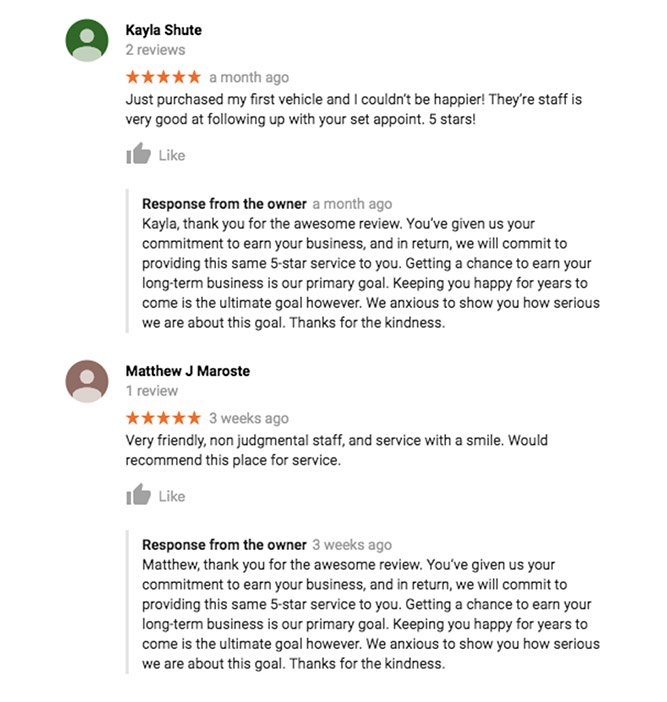
6. The Eager-Beaver Response We know that businesses are enthusiastic about their customers, but it's possible to go overboard when it comes to answering online review. All-caps paragraphs running longer than the review itself, multiple thank yous, excessive emojis and exclamation points all will be overwhelming to the reviewer. Customers should be treated with respect, not pandered to. 7. The Keyword-Less Response This response meets all the basic requirements, but it's missing a huge opportunity: SEO keywords. Terms like the dealership name, car makes and models, and services offered help increase the company's rank in local GMB searches. While not necessarily bad in terms of customer services, these responses aren't doing anything for SEO optimization.
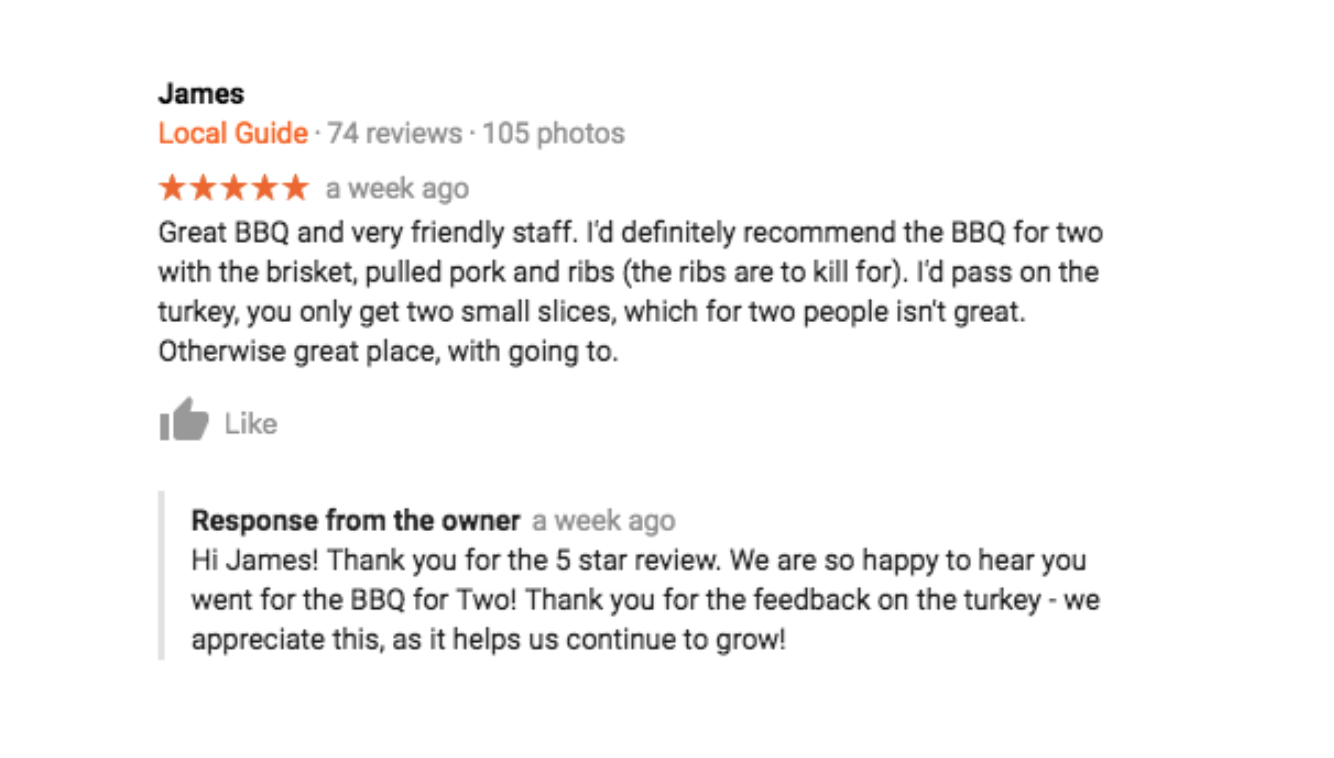
8. The Widewail Response Finally, the best option: a response written by experts. Easy to read, professional with a personal touch, packed full of SEO terms without being clunky. This is the response which will thank current customers properly, boost the company site's ranking with the GMB, and encourage potential clients to give the business a chance. We also know what not to do. Best of all, it requires no additional effort from the team assisting guests in person. They can focus on their job, knowing that their clients will be well taken care of even after they leave the store. Read more about the tactics used by the Widewail team when responding to positive and negative reviews in the upcoming sections.

Best practices for responding to positive reviews
How to respond to positive reviews: Work keywords into your positive review responses Use the customer's name If a customer mentions a product, repeat it in your response Mention additional products you sell Share your company values No big surprise here - your business should be responding to all positive reviews. A common mistake is to respond only to unhappy customers. Operationally this makes sense, but because Google tends to favor reviews that are engaged with, by only responding to negative reviews you run the risk of pushing that content to the top of your page. Avoid this by responding to all of your customers. Positive reviews are a way to engage with happy customers and keep the conversation going after the sale. A positive response to a positive review will leave a good impression on the customer, leading to a higher probability of repeat business. Work keywords into your positive review responses As mentioned above, a positive review response is an obstacle-free opportunity to add relevant keywords to your GMB (without keyword stuffing). Local business keywords are generally business name, location, products, and services.
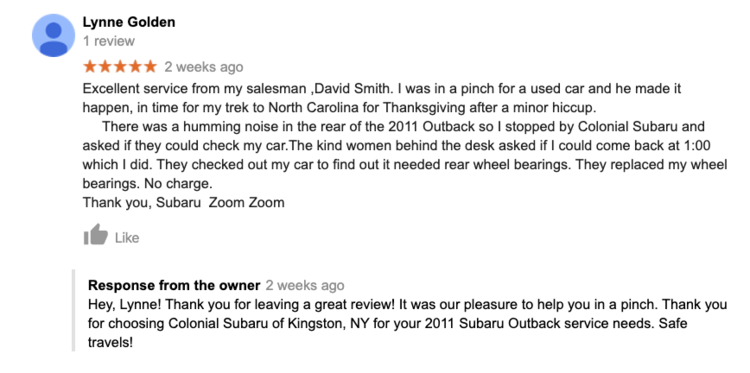
Use the customer's name Adding the reviewer's name to the response is an easy personal touch.
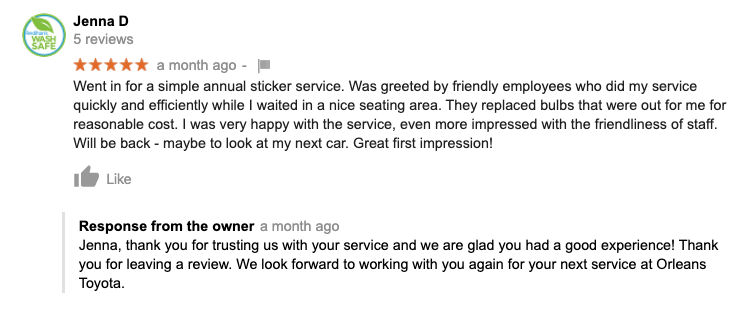
If a customer mentions a product, repeat it in the response If the customer mentioned the make or model of the vehicle they purchased, be sure to include it in your review response. If you aren't sure which vehicle the customer purchased, don't guess!
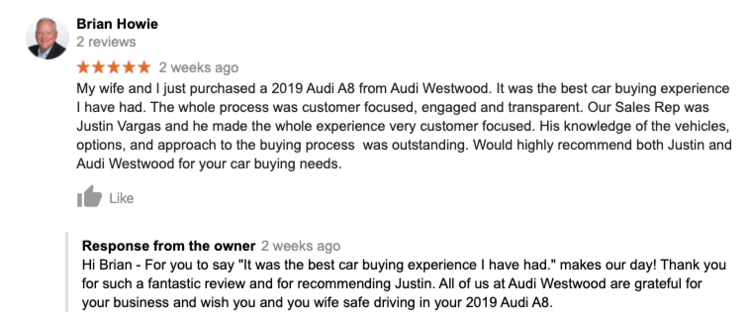
*Note - It is common for reviewers to use shorthand versions of the model they purchased (i.e. "2019 Civic"). Your response is an opportunity to include the full keyword set, "2019 Honda Civic." Mention other products Another way to make the most out of your review response is to mention other products the customer could potentially purchase in the future.
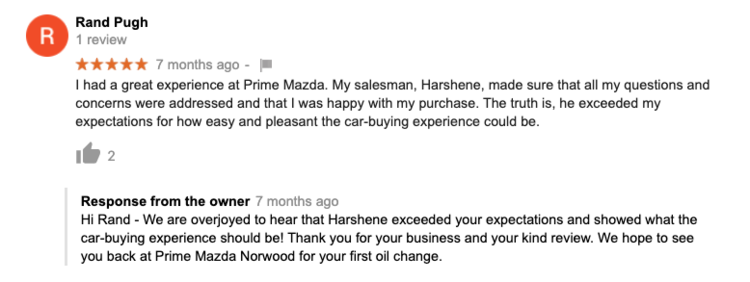
Warning: it can be easy to go overboard when adding keywords. Make sure you are confident that the additional product you are recommending is useful to the reviewer. Share your company values Identify some of your business's core values. For example, your business may pride itself on offering a transparent and stress-free shopping experience. Use the review response as an opportunity to communicate that to future customers - the people reading your reviews!
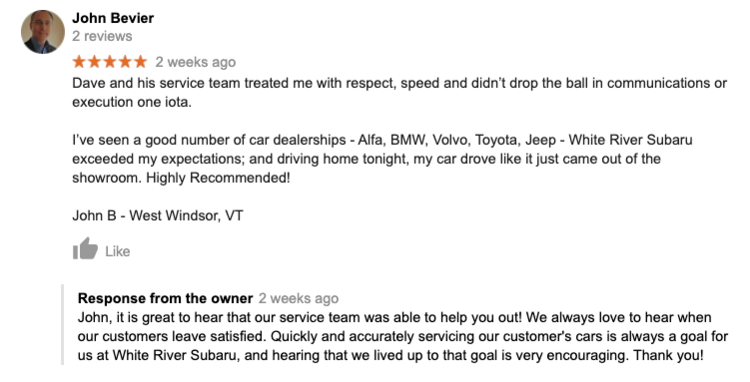
Other tips Avoid repetition whenever possible. While it's challenging to come up with different ways to say essentially the same thing, variety is key to providing personalized service to your customers. One simple way to vary review responses is to switch between "I" and "we." For example, "I am glad to hear that you had a good experience" vs. "we thank you for sharing your positive experience." If a customer indicates loyalty or repeat business in their review, acknowledge that in your response. Positive review responses should always be conversational. Anyone reading the response should be able to tell it was written by a real person. This is especially important to remember when including keywords. While you want to get the most SEO benefits possible, make sure that your responses are tasteful above all else.
11 Positive Review Response Examples
We've collected a handful of examples on how to respond to positive Google reviews. These examples are real customer reviews and responses sourced from Google. We've tried to select a variety of scenarios.

Why it works This response checks the boxes for almost all of the positive review response tactics: It's personal, repeating the name of the employee listed in the review It reiterates the company values mentioned by the reviewer, such as timely communication and professionalism It includes the store name and a prompt for the reviewer to come back for another service. Finally, an emphasis is placed on saying thank you. Remember, customers with positive experiences have limited motivation to post a review, so it is important to show your appreciation. What you should steal: The line "thank you so much for sharing" is an awesome way to acknowledge the extra effort this customer put forth on the business's behalf.
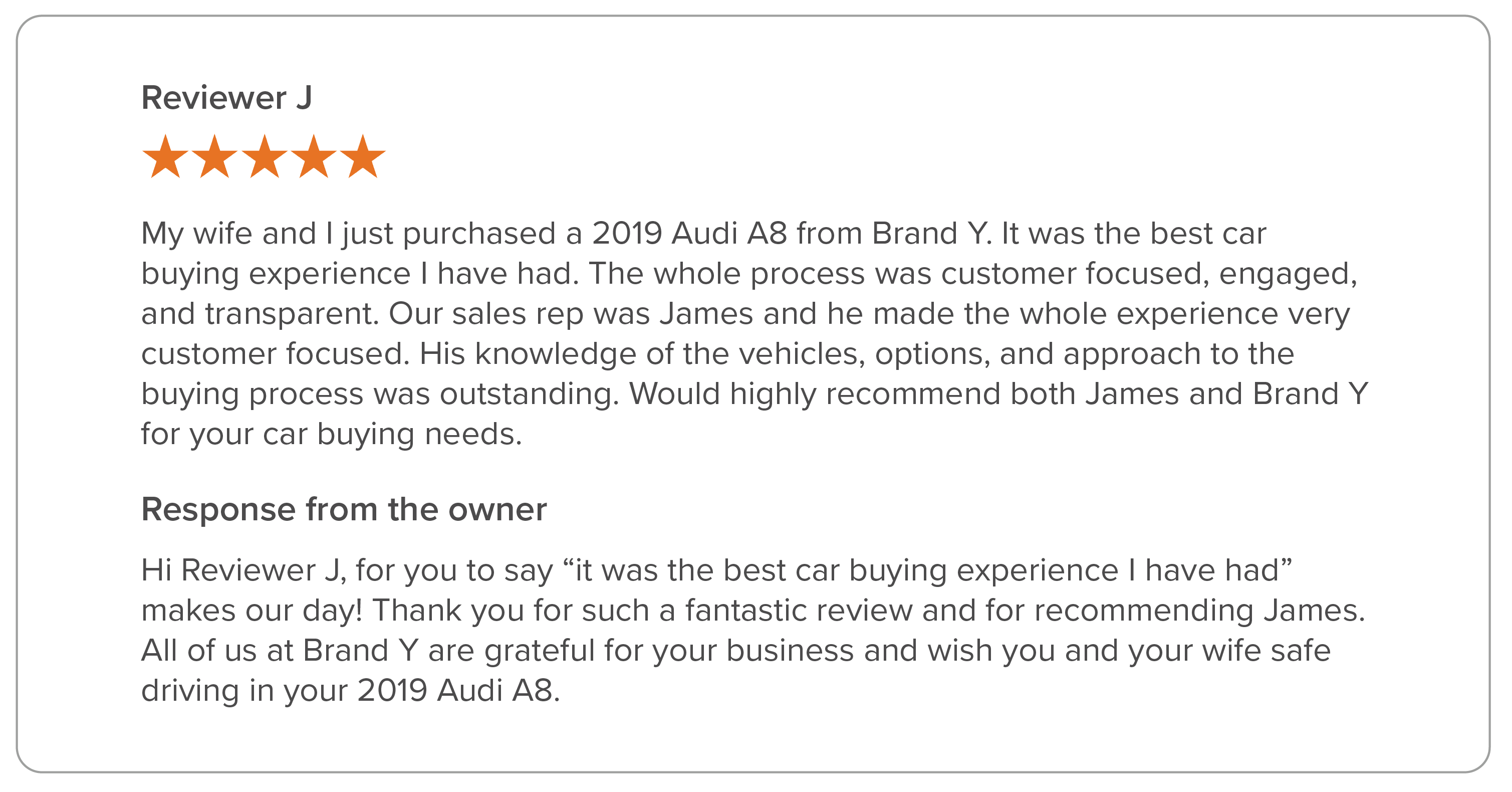
Why it works As you can see in this response, commenting on how a positive review "makes our day" is a nice personal touch. What you should steal: The words "fantastic" and "grateful" are descriptive adjectives to consider. Most importantly, all the basics are covered: the customer name, the store name, and the product name are all mentioned.

Why it works When customers make a successful purchase, especially a large purchase such as a car, they often have a sense of accomplishment. Engage with this emotion by offering your congratulations. If a customer offers praise of a specific employee, use it as an opportunity to repeat their compliments and reinforce that, yes, this person is great. It's not a stretch to assume future customers will look at Luis as an example of the customer service they can expect from this business.
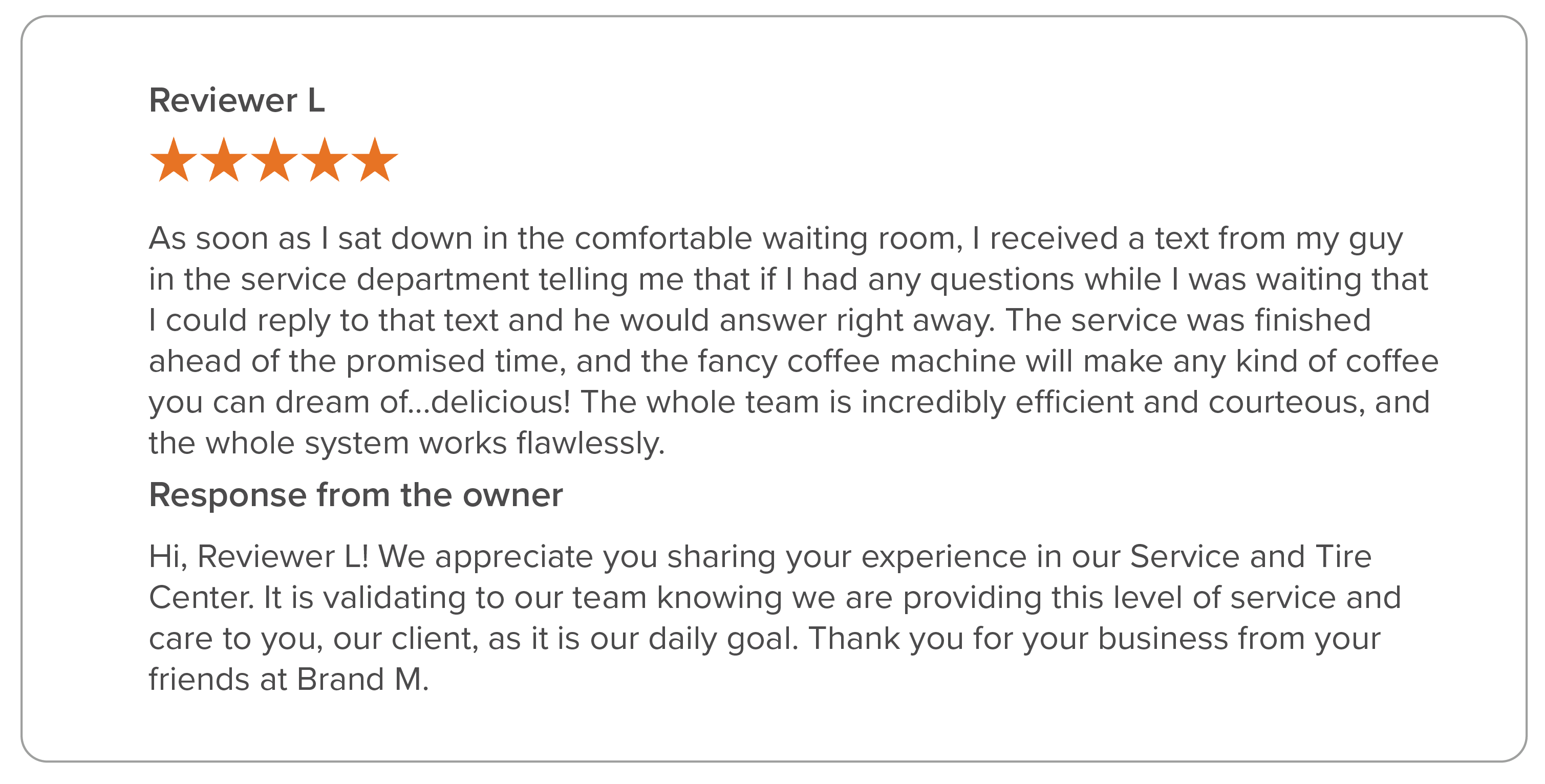
Why it works In their response, the business suggests that they have a daily service goal. This is an excellent way to reinforce that future customers can expect a similar experience, no matter when they choose to patronize the business. What you should steal: "Validating" is a great word to suggest that positive reviews are more than a sign of financial success; they are a personal success as well.

Why it works Starting your response with a quote from the original review is a great way to highlight the most flattering piece of the review. Because this business answers reviews on a consistent basis, they can conclude with the note "this holiday season." What you should steal: time-specific sign-offs are a good way to personalize responses.

Why it works This customer mentions they traveled a long distance to visit the dealership and the response acknowledges their additional effort.

Why it works The phrase "earning your business" helps to portray the business as humble. Nobody wants to deal with arrogance.

Why it works This response does a good job of communicating the business's "great prices," but doesn't come off overly salesy. Ending with a personal statement of well-wishes adds a nice touch.
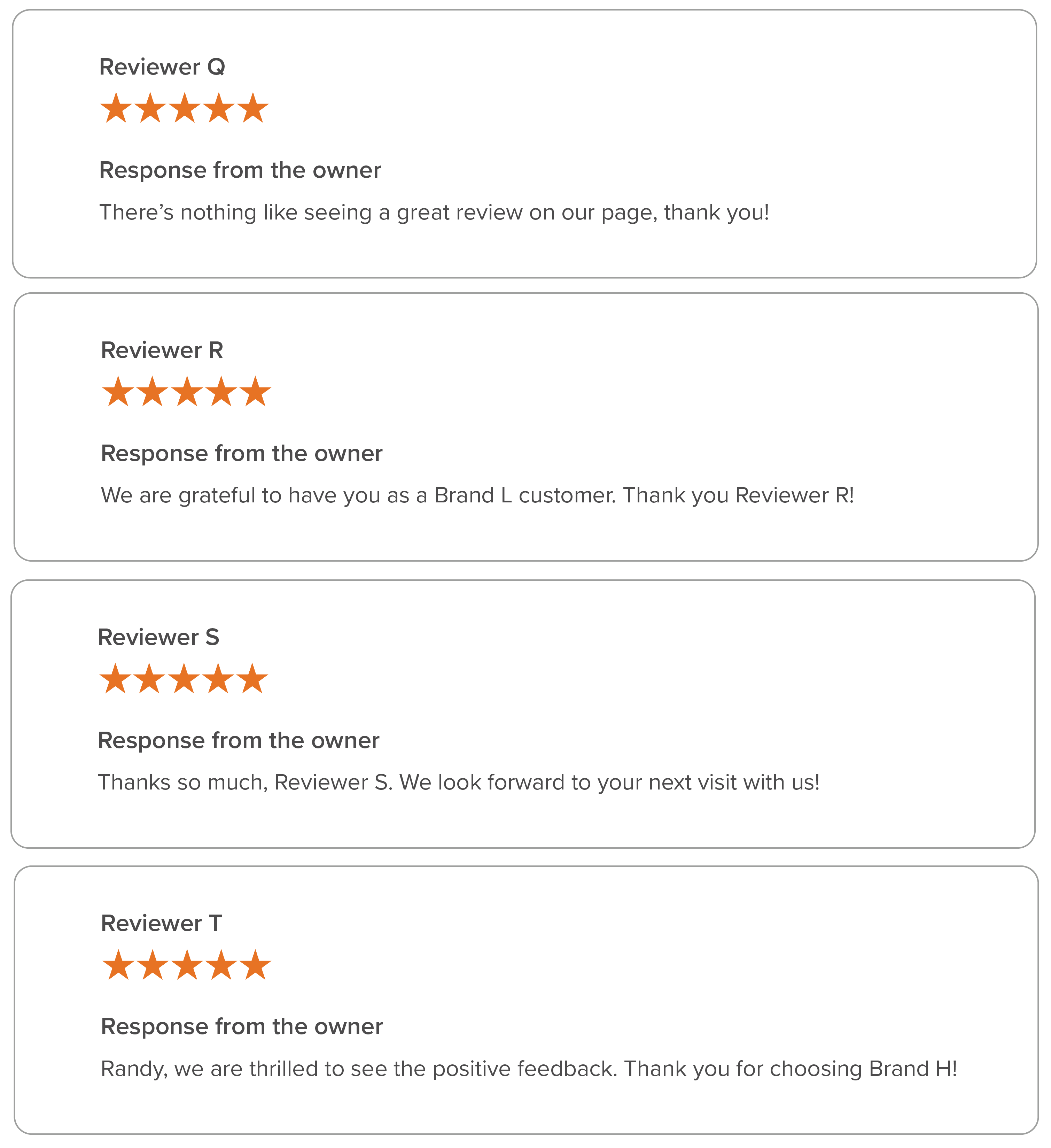
Why it works The most common Google reviews are five-star, no-comment. To make responding easy and ensure a diversity of answers, this business has created a list of response templates. They update the template with the reviewer's name and the business's name before publishing.

Why it works The customer mentions a specific problem the business solved: addressing a flat tire. This information forms the basis of the response.

Why it works Rather than repeating "thank you for the recommendation," this response employs a great alternative: "we appreciate your endorsement." A number of phrases are interchangeable: "we appreciate" and "thank you;" "recommendation" and "endorsement;" "rating" and "review;" "honored that" and "grateful for." Even simple word changes like these make responses seem more unique and more human. Widewail Tip: Switching up perspectives, like swapping "we" with "I," adds variety to responses.
Best practices for responding to negative reviews
How to respond to negative reviews: Stay professional Don't speculate Minimize emotion Present the facts Apologize for the customer's frustration only Do not publicly admit guilt for the material issue Avoid public accusations of review fraud Provide a productive next step
When responding to bad reviews, the #1 goal is to move the conversation offline. Offer to resolve the situation via phone or email and then follow-up with the customer quickly. Google reviews is not the place to get into a debate. Professionalism is key Do your best to avoid being defensive, overly emotional, or sarcastic. Leave out personal opinions about politics, ethics, religion, or social issues. Review responses should remain professional and neutral. Avoid public accusations of review fraud Fake reviews do happen, but you should respond to them in the same manner as any other negative review. If you believe a review is fraudulent, report it through the proper channels. Is it possible to remove negative reviews? Yes, but only if the content violates Google's Review Policy guidelines. Apologize for the customer's frustration only While there are certain situations that require an apology, don't say sorry if it isn't necessary. Focus on apologizing for the fact that the customer is upset and save addressing the material issue for a direct phone call or email. Ideally, you'll demonstrate compassion for your customers without making a public admission of guilt. The next reader knows there are two sides to every story. Provide a productive next step When it makes sense, let the customer know you plan to take action immediately. This will prepare the customer for your call and show future customers your willingness to take action.
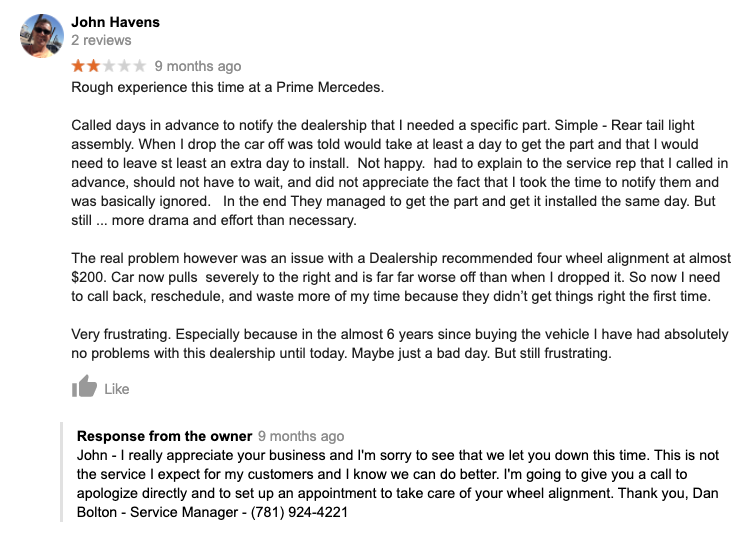
Don't speculate When the customer says that they're frustrated but doesn't say why, what do you do? Don't speculate. Simply acknowledge that the customer is upset and kindly ask them to share more information about their experience with you over the phone.
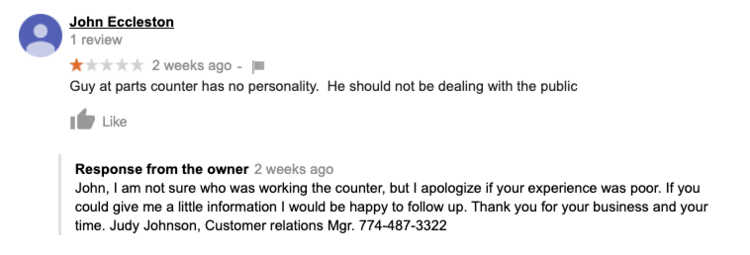
8 Negative Review Response Examples
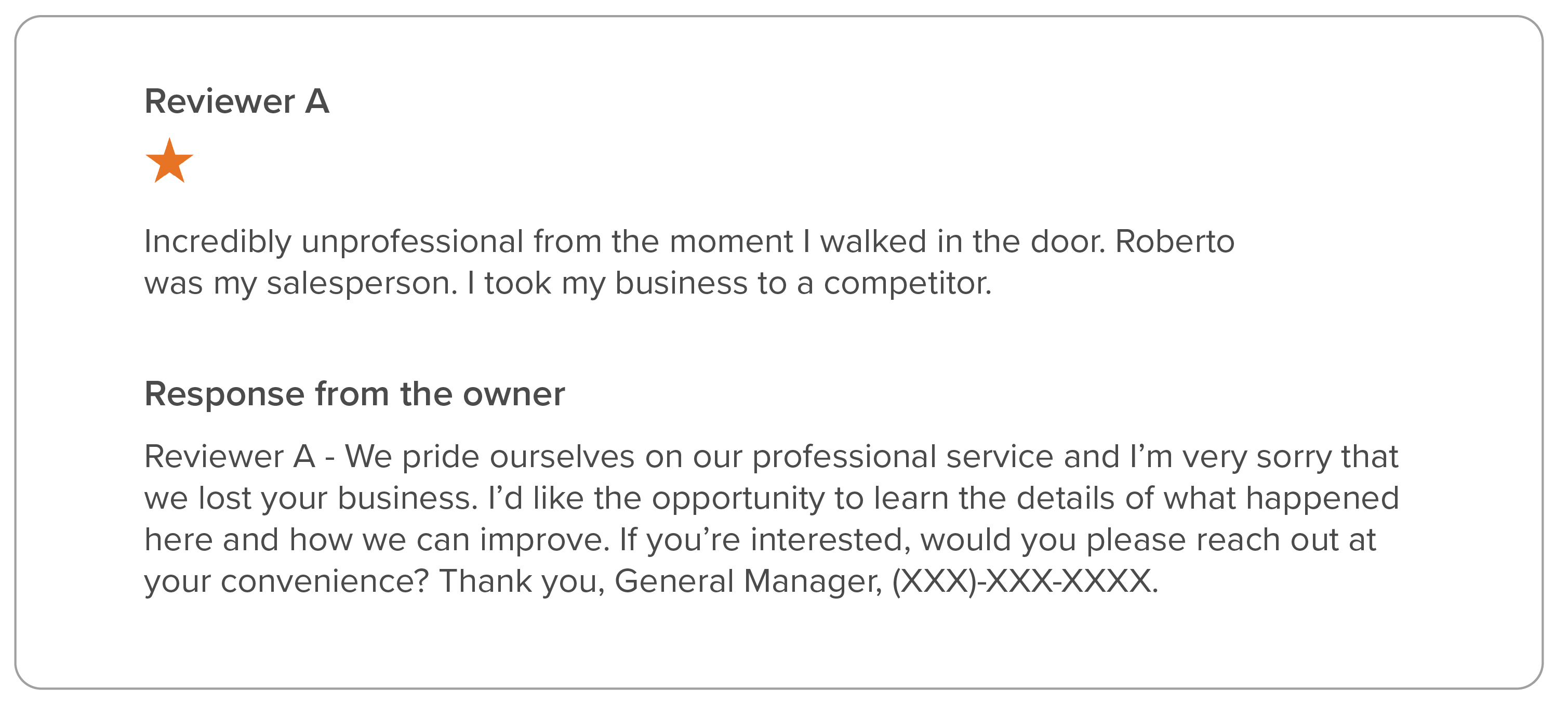
Why it works Reviewer A feels as if they were treated in an unprofessional manner throughout the duration of their experience. They've also admitted to taking their business elsewhere, so there is likely no opportunity to win back the deal. In cases like this one, the business should use this shopper's experience as a learning opportunity. The response starts off by firmly establishing that professionalism is important to their business and they regret having lost Reviewer A's business. Note the response does not explicitly apologize for the cited unprofessional behavior, but simply acknowledges the reviewer's frustration. The response is completed by offering the reviewer an opportunity to discuss their experience further. If the shopper follows up, great! The business will have the chance to address their concerns. If not, future shoppers will see that they are open to customer feedback. Widewail Tip: If you are unable to locate the customer's contact information, politely request they give you a call, leaving a direct phone number at the end of the response.

Why it works Although what Reviewer B has written is a bit confusing, it's easy to understand that they are unsatisfied with the service they received and the delay in their repairs. This perspective may or may not be accurate, but as responders, it's not our job to get to the truth. Our goal is to empathize with the customer's frustration, which is undeniably true, and then request the conversation move offline. The response begins by acknowledging the customer's frustration and acknowledge that this treatment is not acceptable by the standards of the business. It's important to identify the negative scenario as an isolated event so that future readers will understand the situation described in the review is not the business's normal operating procedure. Use of the phrase "concerning details" demonstrates that the business is taking the review seriously, but at the same time, is purposefully vague. It's best to avoid repeating details from the review, as this provides Google with content that is detrimental to your reputation. The review ends by offering the customer an opportunity to share more about their situation along with providing contact information. Widewail Tip: If the business has Reviewer B's phone number, a more proactive approach would be to say "I'm going to give you a call" in place of "please consider giving me a call."

Why it works The dreaded 1-star no comment. On one hand, future customers won't have much information to assess the business and they may even question the validity of the review. On the other hand, they may speculate why this customer is upset. First, we recommend whomever handles review responses look up the customer's name in their database and check in with their team. They may glean enough information to reach out to the customer directly or provide a specific response. If after researching they are still left in the dark, the best option is to investigate. The response starts by recognizing that a 1-star experience is unacceptable. What follows is an offer to address the reviewer's concerns. The business provides contact information for their General Sales Manager in hopes that Reviewer C will give them another chance. Widewail Tip: "Make this right" is a proactive phrase that will come in handy when responding to negative reviews.

Why it works Although this is a 4-star review, it contains a healthy amount of negative information. This is a great opportunity for the business to engage with Reviewer D in a positive manner. If they can do that, they might encourage Reviewer D to give them another shot. Right away, the response acknowledges Reviewer D's feelings and apologizes for their less-than-perfect visit. The business doesn't make a promise to improve their facilities, but they do recognize the feedback. As always, a good move is to open a communication channel in the event that the reviewer would like to share more details. Shifting the perspective, the last sentence expresses that the business hopes to work with this customer again and provide a better experience in the future. Widewail Tip: While one complaint about facilities shouldn't cause concern, a pattern of similar feedback could prompt upgrades.

Why it works Online requests for refunds can be tricky. While businesses may be eager to demonstrate that they do right by their customers, each situation needs to be considered on a case-by-case basis. The response to Reviewer E acknowledges the customer's frustration and then offers to review the situation in more detail. Although it may not be possible for the Service Manager to find a solution that satisfies Reviewer E, at the very least she may provide information that could help them approach a similar situation differently in the future. From the lens of reputation management, the response demonstrates that the business monitors their feedback and communicates with their customers.

Why it works Reviewer F's situation certainly sounds frustrating. At the same time, it's understandable that staff turnover could lead to mistakes and miscommunications. This response benefits from a gracious perspective - "appreciate you sharing" - and an apology. Widewail Tip: The phrase "training opportunity" demonstrates that your business takes feedback seriously and proactively addresses customer concerns.
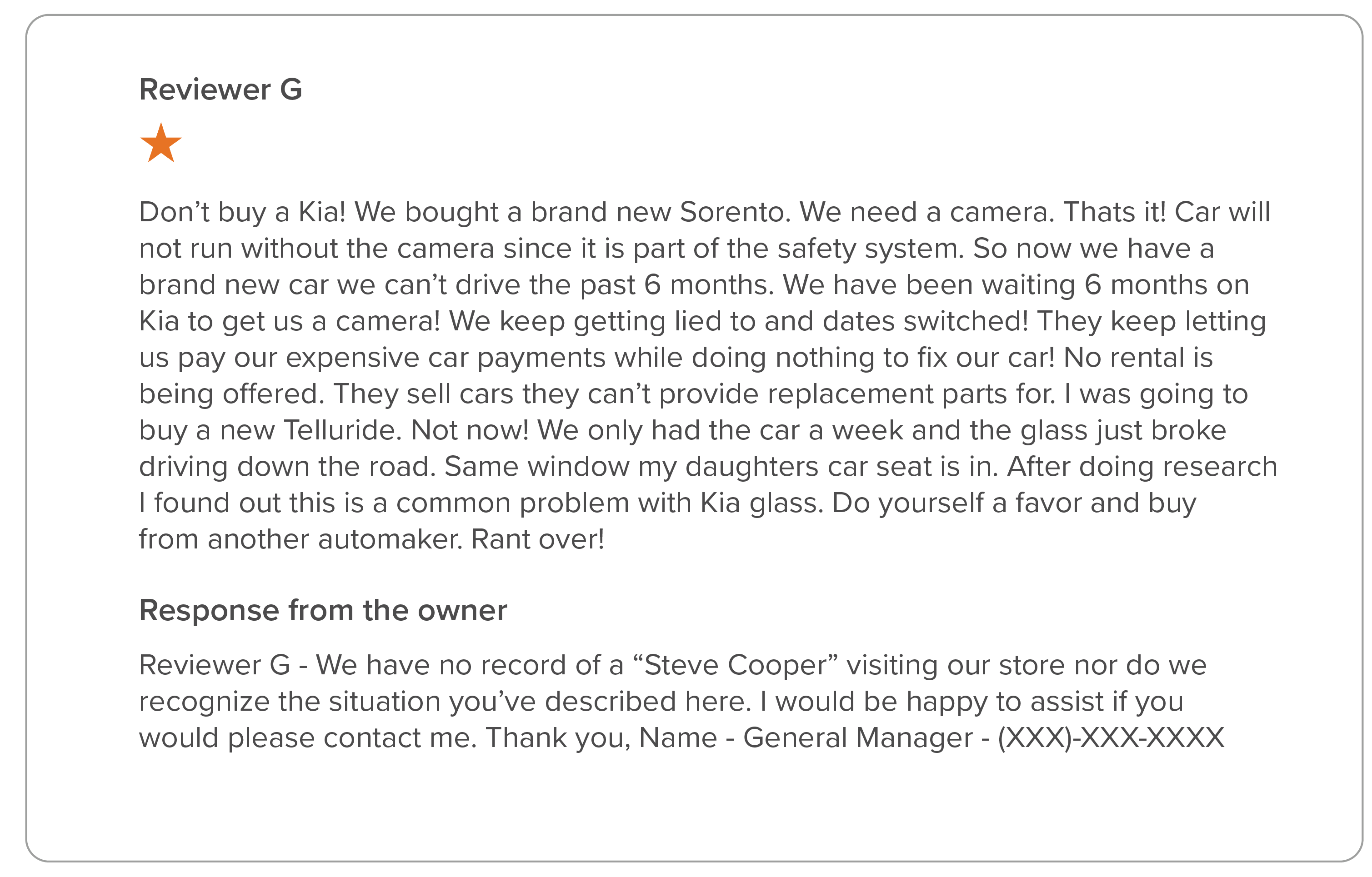
Why it works Always be polite when speaking for your business online, but don't be afraid to hold your ground if the information presented does not align with your experience. In this example, a firm and straightforward response clearly communicates parts of this situation are not explained in the review.
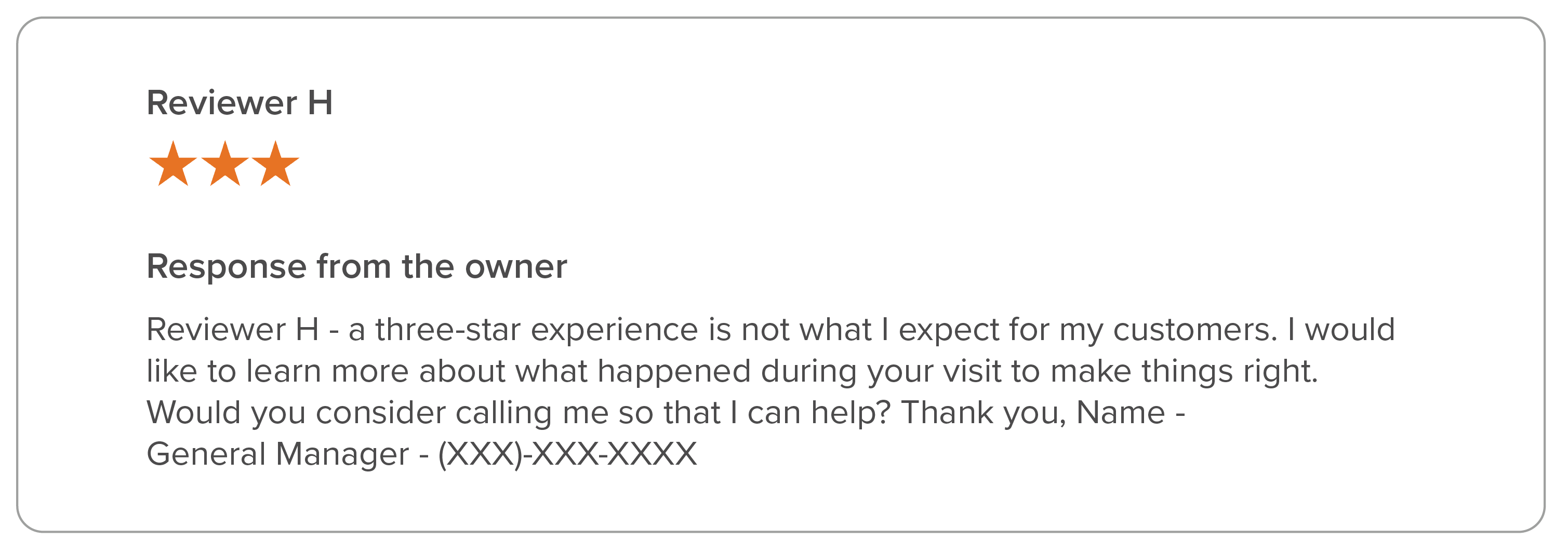
Why it works When a customer leaves a negative no-comment review, Widewail recommends that businesses request additional information. The first line in the response above is one approach, while something like "I'm sorry you were not completely satisfied with your visit" is also appropriate. This response is a great template to have readily available as a reference for negative no-comment reviews.
Reporting At Widewail we offer a detailed performance report as a component of our services. Using our reporting your team is able to analyze performance by location, review site, profit center, and time period. Is your sales department underperforming your service department? When responding to reviews our team tags each review with the relevant profit center. As a result, we can compile a report that shares insights into specific profit center performance. For example, we see below that Location 1 has a combined rating of 4.5, but profit center 1 is scoring a 4.8 and profit center 3 is scoring a 3.9. This segmentation helps you to identify specific customer service issues. While Google's star rating is a lifetime aggregate, Widewail's reporting enables customizable, date-specific, trending performance analysis. Service ratings trending sharply down? Our reporting gives you the specific information needed to solve issues early. Widewail client reduces negative reviews by 64% in 9 months.How do you know if your review management strategy is working?

When all the techniques are properly implemented sometimes an unhappy customer can turn into a happy customer. This is what we want!Bonus: Example of a "Widewail Save"
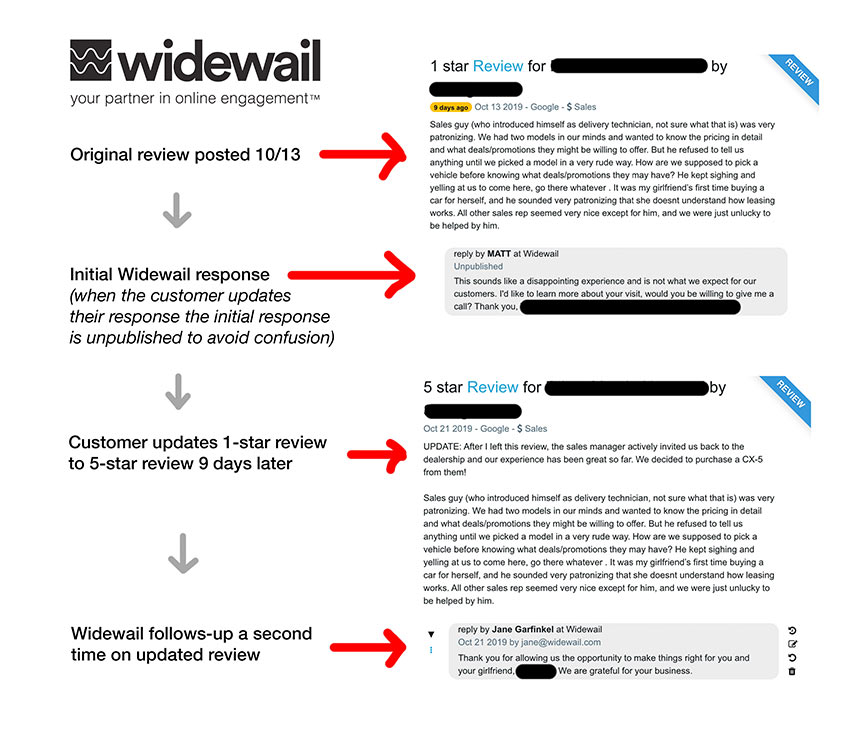
How To Respond To A 1 Star Review Without Comments
Source: https://www.widewail.com/guide-review-response
Posted by: upshawwishoune1988.blogspot.com

0 Response to "How To Respond To A 1 Star Review Without Comments"
Post a Comment